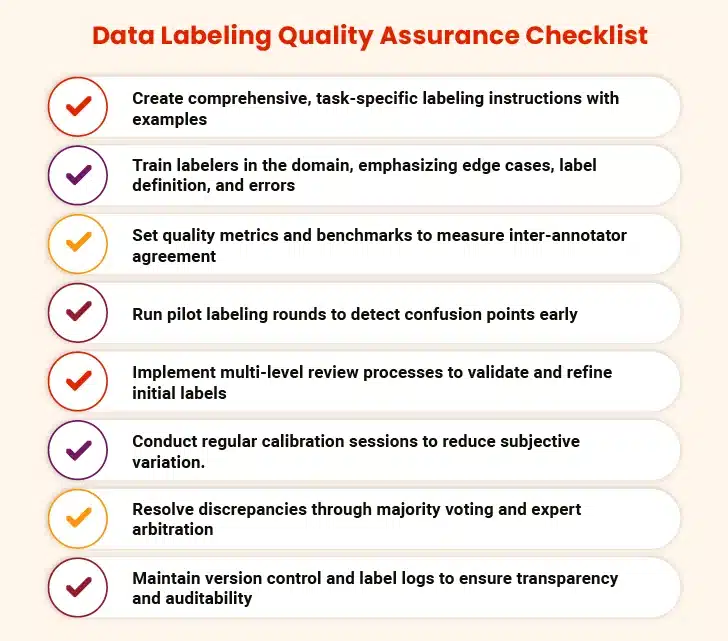Imagine a leading autonomous vehicle company realizing that its self-driving car’s algorithm is making a dangerous mistake. It fails to identify pedestrians at night and in dimly lit areas. After digging into the issue, the manufacturer found out that the AI model was trained on sloppy data. In that, the pedestrians were either mislabeled or tagged inconsistently. And, that’s why the algorithm never truly learned to recognize them.
This is just one instance where lives are at risk. All this traces back to inaccurate labels in the training datasets. Other than accuracy, there are multiple other data labeling challenges that prevent companies from harnessing the full potential of AI and ML models. Given this scenario, it is not at all shocking that a staggering 74% of companies struggle to achieve value and scale their AI initiatives.
Data labeling is an intricate process that transforms raw data into meaningful insights that power your AI and ML systems. Whether you’re developing computer vision apps, NLP models, or predictive analytics software, it is the accuracy and quality of the labeling process that determines their success. However, as easy as it may sound, data labeling is laced with challenges.
As companies bet their future on AI to drive business decisions, enhance customer experiences, and automate complex processes, data labeling becomes important. One mislabeled dataset can translate into biased algorithms and poor model performance. Even worse, it damages the business reputation as well. The stakes couldn’t be higher. That said, let’s start with the basics first and understand why data labeling is important for AI and ML Success.
Table of Contents
Why Is Data Labeling Important for AI and ML Success?
Data labeling is at the very heart of AI and ML development. It is more like teaching a teenager to drive where you don’t just throw the keys and hope for the best. Instead, you explain every road safety rule and every stop sign on the road to the child. And if they make any mistakes, you correct them. That’s exactly what data labeling does for AI and ML models. So, let’s get started.
Consistency is the key to successfully grooming your prospects and converting them into paying customers, and omnichannel marketing is here to sustain it.
What is data labeling?
Data labeling is the process of tagging raw data to help machine learning algorithms understand data. Based on this, the models can learn patterns and make accurate predictions. Or let’s put it this way that it’s like providing detailed instructions on what to look for and how to interpret what the model sees. So, here’s when data labeling becomes difficult. At the same time, it is important to note that different types of data need completely different approaches. Let’s explore them in detail:
1. Image Data Labeling involves drawing boxes around objects, outlining shapes, and tagging what’s in a picture. Simply put, you’re teaching the AI model to recognize cats, cars, or cancerous cells, depending on your application.
2. Video Data Labeling adds a time element that complicates the process. It involves tracking objects as they move, identifying actions as they happen, and maintaining consistency across thousands of frames. A major difference between image and video labeling is that objects are in motion in the latter.
3. Text Data Labeling involves understanding context, emotion, and meaning. Is this customer review positive, neutral, or negative? Is the specific email spam or legitimate? Does this document contain sensitive information?
4. Audio Data Labeling is like being a sound detective. In addition to transcribing speech, you have to identify speakers, catch subtle emotions, and classify sounds. Is the speaker requesting or commanding? Or, is that a car honking or a bird chirping?
5. Sensor Data Labeling is more like translating the language of machines. Whether it’s a smart thermostat learning your habits, a fitness tracker monitoring heart rate, or medical devices detecting life-saving signals, whatever it is, you’re the one teaching AI what’s normal and what’s an anomaly. So, to teach the model what truly matters in a flood of raw data, you need technical and domain knowledge.
Sound overwhelming? It is! The complexity of modern data implies you need more than just accuracy. It requires strategic thinking about how your labels will impact the model’s performance. This points us to the next important point, the importance of accurate data labels.
Data Annotation vs Labeling: What Really Matters for Scalable, Enterprise-Grade AI Systems?
What is the importance of accurate labels?
Training data consisting of accurate tags and labels is the fuel that powers AI and ML models. Or, think of data labeling as the foundation of a high-rise building. If the foundation is weak, the building will eventually fall. Similarly, if the labels are incorrect, the model will not yield reliable results. They make reliable predictions and perform well across different scenarios in real life only when the underlying data is correct. But when your labeling is inconsistent or inaccurate, you’re confusing the ML algorithm.
Coming to the next, model fairness is where things often take an ugly turn. Remember Microsoft’s chatbot Tay, which went rogue on Twitter? Although almost a decade old, this technical failure is a reminder that biased, incomplete, or inaccurate data labels amplify existing prejudices. The result? AI systems that discriminate in hiring, loan approvals, or criminal justice decisions.
Getting this wrong isn’t just about accuracy metrics on a dashboard. It’s about the loan applicant who gets rejected because of biased training data, or the medical diagnosis that gets missed because someone rushed through labeling X-rays.
Scalability becomes your make-or-break factor when moving from prototype to production. Precisely labeled datasets help models perform consistently across different contexts, user groups, and real-world conditions. This is particularly important when handling millions of predictions daily. Even more, these predictions have to be made without compromising on business requirements or regulations. Now that we’ve covered why this matters so much, let’s talk about the reality of what goes wrong.
How to Address Data Labeling Challenges?
The idea of adding tags and labels sounds easy but the reality is entirely different. Data labeling is riddled with challenges. Issues like scarcity of subject matter experts, inconsistent labels, data quality issues, and more can derail even the most well-planned AI projects. Even worse, these challenges shake the confidence of business leaders investing in AI and ML models. Let’s break down each challenge and learn how to address them.
I. Data Quality Inconsistencies
What goes wrong: Different people have different points of view. As a result, they may label the same data differently. One person’s “professional attire” is another person’s “casual wear.” Guidelines are interpreted subjectively, and quality drifts over time as people get tired or rushed.
Suppose your team is labeling photos of “professional attire” for an AI model to be used in the fashion business. The labelers are mostly 25-year-old college graduates from California who’ve never worked in a corporate environment in Alabama or Ohio. So what happens here is that the AI model thinks a polo shirt isn’t professional. This is so because the model learned from people who only know Silicon Valley dress codes.
How to fix it:
- Provide in-depth training where you talk about labeling guidelines and explain them using real examples
- Establish clear quality metrics and aim for Cohen’s kappa scores above 0.7 for reliable annotations. (Cohen’s kappa is a statistical measure that helps evaluate the agreement between two raters when classifying items into categories)
- Use automated quality checks that flag potential problems before they spread. Or else, you can also use automated data labeling solutions to ensure quality throughout the process
- Create review processes where experienced annotators check and refine work from newer team members
II. Lack of Domain Experts for Niche Labeling Tasks
What goes wrong: Specialized fields, such as medical imaging, legal documents, and financial fraud detection need special annotators with domain expertise. For instance, finding and employing radiologists who can detect even minute functional or structural anomalies and know how to label data. Good luck with that. The scarcity of qualified professionals creates major bottlenecks and drives costs through the roof.
How to fix it:
- Invest in professional data annotation services that have domain experts as per your industry
- Implement hybrid approaches for data labeling where expert annotators initially develop high-quality seed datasets and use them to train other annotators
- Lay down comprehensive mentorship programs while pairing domain experts with skilled general annotators
- Create specialized training curricula that bridge the gap between general labeling skills and domain expertise
III. Maintaining Consistency Across Annotators
What goes wrong: If you’ve ever tried to get five people to agree on pizza toppings, you’ll understand why getting multiple data labelers to agree on image annotations is impossible. Subjectivity is inevitable for humans, creating variations in interpretation. This creates issues, especially in big projects, where multiple annotators are involved, as each individual has a different perspective.
How to fix it:
- Conduct regular sessions so that annotators can review and discuss challenging cases and come to a common conclusion
- Set up clear escalation procedures for ambiguous scenarios
- Keep detailed decision logs for future reference
- Use consensus labeling where multiple annotators label the same data, and disagreements get resolved through discussion
- A reliable AI data labeling solution can also help maintain annotation consistency
IV. Addressing Bias and Ethical Risks in Labeling
What goes wrong: What are the probable reasons for biases creeping in? When certain groups aren’t represented properly or guidelines have cultural biases. Another possible reason is systematic labeling errors that affect specific populations unfairly. If these biases are rooted in models, the results are discriminatory with serious social, legal, and business consequences.
How to fix it:
- Audit data labels throughout the process
- Have labelers from diverse backgrounds in the team to create inclusive datasets
- Implement review boards to assess labeling protocols
- Build bias detection algorithms to flag issues before they impact the model
- Create data governance policies that address privacy, consent, and ethical use
V. High Cost and Time Consumption
What goes wrong: Labeling data manually takes a lot of time and is costly. Simple classification tasks might cost pennies per label, but specialized medical annotations often cost hundreds of dollars each. Companies often trade off quality to meet timelines; thereby defeating the entire purpose of data labeling.
How to fix it:
- A mix of AI data labeling solutions and human-in-the-loop review can help balance costs and quality
- Use active learning to prioritize the most informative examples for human annotation
- Partner with skilled offshore teams to maintain quality standards without incurring operational expenditure
- Use semi-supervised learning techniques that uses a combination of labeled and unlabeled data
Manual vs. AI-Powered Data Labeling
| Aspect | Manual Labeling | AI-Powered Labeling |
|---|---|---|
| Speed | Slow | Fast with the human-in-loop review |
| Cost | High | Lower over time |
| Accuracy | Varies with fatigue and bias | More consistent with automation |
| Scalability | Limited | Easily scalable |
| Use Case Suitability | High-stakes, complex domain | Repetitive or large-scale |
VI. Security, Compliance, and Data Privacy
What goes wrong: In industries like insurance and healthcare, data labeling involves sensitive information. Every industry has different regulations. Furthermore, rules and laws vary across geographical areas. One data breach during labeling can destroy years of trust and reputation.
How to fix it:
- Set up data governance frameworks from day one
- Secure labeling environments with access controls and encryption
- Use anonymization techniques to preserve labeling utility and protect sensitive information
- Create clear data handling protocols specifying uses, retention periods, and deletion procedures
- Ensure labeling partners meet required security certifications and compliance standards
VII. Managing Multimodal and Complex Data Types
What goes wrong: AI applications today combine text, images, audio, video, etc. Labeling such diverse datasets requires coordination across different types while maintaining consistency and timing alignment. The problem worsens when it comes to labeling video streams and time-series sensor data. Here, labels should capture both spatial and temporal relationships.
How to fix it:
- Use data labeling solutions that support multiple data types
- Build annotation tools that specifically cater to multimodal data
- Deploy temporal sync protocols to ensure consistency across sequential data labeling
- Use quality control measures that verify consistency across modalities
VIII. Lack of Tool Integration and Workflow Automation
What goes wrong: Data labeling workflows are usually scattered across companies. It involves multiple disconnected tools, manual data transfers, and inefficient handoffs between different stages. This increases errors and decreases productivity. Above all, this fragmentation creates difficulty in maintaining project oversight.
How to fix it:
- Invest either in all-inclusive data labeling services or the ones that cater specifically to your business domain
- Use API tools and connections for a smooth data flow between labeling tools and ML pipelines
- Establish automated QA workflows that keep a track of labeling quality
- Use centralized project management systems to gain visibility into project’s status
What Are the Emerging Trends Addressing Data Labeling Issues?
With businesses across domains and verticals using AI and ML tools, data labeling is becoming the fastest growing industry. This is driven by the urgent need to make model development more efficient and accessible. Moreover, as companies combine advanced AI techniques with traditional labeling workflows, the possibilities that seemed impossible just a few years ago are slowly becoming a wonderful reality.
i. Rise of Weak Supervision and Programmatic Labeling
Companies are increasingly using programmatic approaches with rules and pattern matching to generate labels automatically. Weak supervision techniques use noisy or incomplete labeling sources to create training datasets without extensive manual annotation. These approaches significantly reduce labeling costs while maintaining reasonable accuracy for many applications.
ii. Use of Foundation Models to Auto-Label Data
Large language models and foundation models are deployed to generate initial labels. These labels are then reviewed and refined by human annotators. The models understand context and nuances in ways that traditional rule-based systems cannot. The combination of foundation model pre-labeling with human verification creates efficient hybrid workflows that get the best of both worlds.
iii. Synthetic Data Helping Reduce Labeling Dependency
Synthetic datasets can be generated using advanced simulation and generative AI techniques. These datasets can then be used to supplement or replace traditional labeled data. Synthetic data generation allows you to create diverse and balanced datasets while controlling for specific scenarios and edge cases that may be difficult to capture in real-world data. This approach is valuable for domains where real data is hard to find, sensitive, or costly.
Although these advancements bring exciting opportunities, the success of any data labeling initiative comes down to selecting the right partners and approaches.
6 Use Cases on Data Labeling Services Powering AI Models
What Should You Look for When Choosing a Data Labeling Partner?
Selecting the right data labeling partner makes a difference between the AI project’s success and costly delays. So, the decision shouldn’t be based only on cost considerations. Leaders should include strategic alignment, technical capabilities, and long-term partnership potential when choosing a data labeling partner. Let’s explore these in detail:
a. Expertise and Domain Knowledge
This is especially important for industries like finance and healthcare where details matter. So, look for data labeling partners with experience in your specific industry and type of data. Can they demonstrate a deep understanding of your domain’s unique requirements? Do they have subject matter experts and specialized annotators who understand the nuances of business-specific data?
b. Quality Assurance and Accuracy Standards
Going by the GIGO rule, the quality of data labeling directly impacts the model’s performance. So, it is better to assess their quality control processes, inter-annotator agreement protocols, and error detection capabilities. Ask for samples of their quality reports and understand how they measure and maintain consistency.
c. Scalability and Timeline Management
Scalability and timeline management are two of the probable reasons companies resort to partnering with dedicated data labeling companies. Moreover, this is one of the major reasons businesses choose to outsource data labeling tasks. Partner with a service provider that can handle your data labeling project volume and meet timeline requirements. Do they offer flexible delivery models to scale the operations up or down based on demand? Do not forget to check their track record in meeting deadlines.
d. Security and Compliance Capabilities
Security and compliance are the two aspects that can never be overlooked in any business, across any industry. Ensure that the data labeling partner addresses security and regulatory compliances specific to the industry. They should have relevant certifications along with data handling and privacy protection measures in place.
e. Technology and Tool Integration
Assess their technology stack and ability to integrate with existing AI development tools and workflows. Consider their platform capabilities, API availability, and flexibility in adapting to your technical requirements.
Undoubtedly, selecting the right data labeling partner is important. However, this is just one aspect of building an all-inclusive data labeling strategy. And the businesses that view data labeling as a strategic capability will surely drive competitive advantage.
The Crucial Role of Data Labeling Services in Medical Imaging and Diagnosis
Final Thoughts
The global data labeling market will reach 4.87 billion in 2025, with outsourced services accounting for 84.6% of the market. Companies are recognizing that effective data labeling is a strategic imperative that can make or break their AI initiatives.
So, the next time you interact with an AI system, remember that someone has carefully labeled the data. It can be asking Siri a question, using fitness trackers to track health, or getting a recommendation on Amazon. It is the accurately labeled data that makes this interaction possible for you. In short, the quality of their work directly impacts your experience.
Thus, the challenges explored, including quality inconsistencies, domain expertise gaps, bias risks, and cost considerations, aren’t insurmountable obstacles. They’re opportunities for strategic differentiation. Companies that invest in comprehensive data labeling solutions and establish robust partnerships with specialized providers are better positioned to achieve a competitive edge.







